Trellis refers to a structure that provides support and guidance for climbing plants. It is like a framework on which these plants can grow and thrive. A trellis can be made from various materials such as wood, metal, bamboo, wire, or mesh. The main advantage is that a trellis provides climbing plants support, allowing them to grow vertically. This is especially valuable if you have a limited ground area.
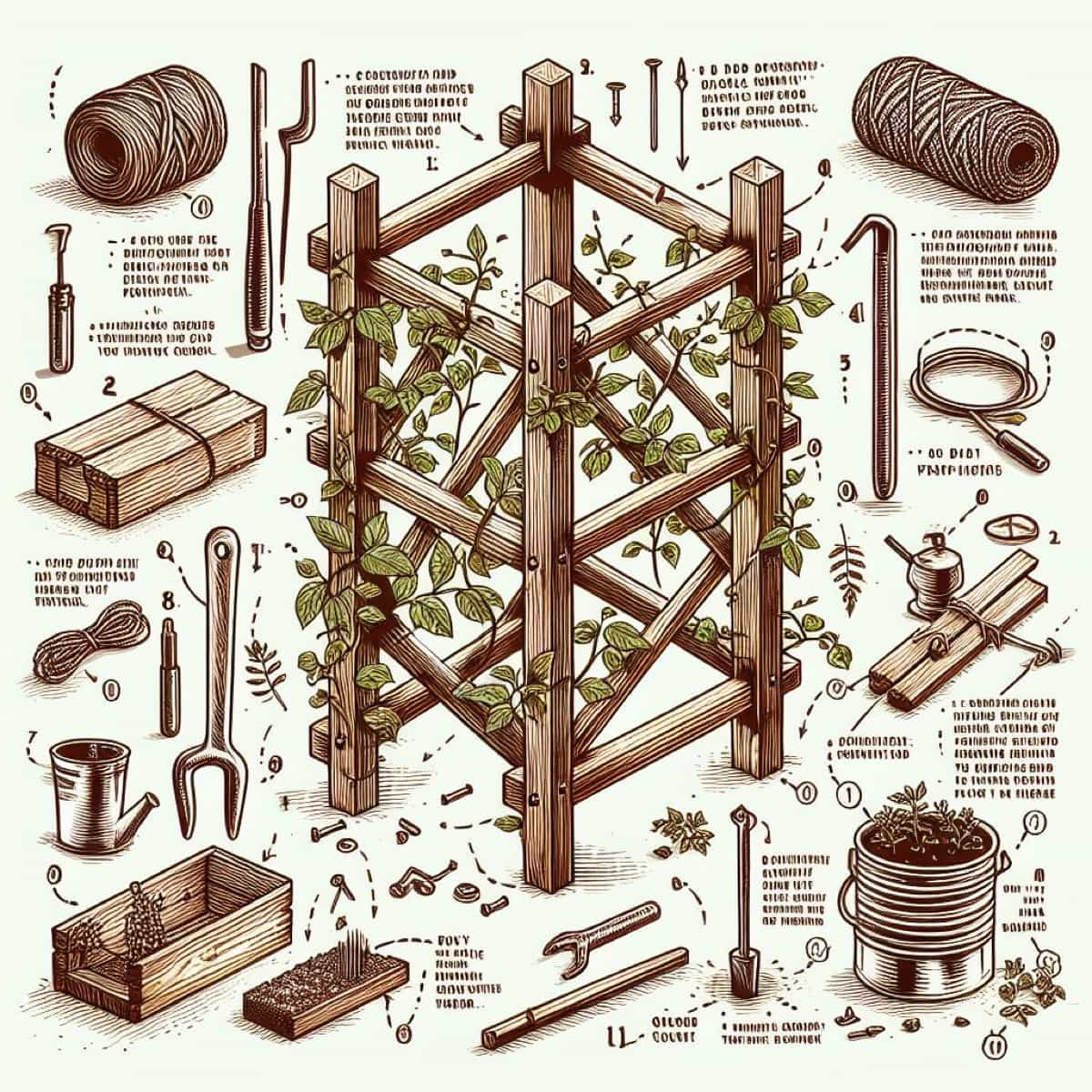
Build Your Own Trellis
Types of Plant Supports
Wooden Trellis
A classic choice, wooden trellises provide a natural and rustic look to any garden. To build a wooden trellis, start by selecting the type of wood you want to use. Cedar and redwood are the best choices because they are naturally resistant to insects. Next, decide on the style of your trellis, whether it’s a simple lattice pattern or an intricate design with multiple panels. Once you have your materials ready, measure out the dimensions for your trellis and cut the wood accordingly.
Assemble the pieces using screws or nails, making sure everything is secure. You can also add decorative elements like finials or paint/stain your trellis to match your garden aesthetic. Climbing Roses, Clematis, Morning Glories, and Sweet Peas all thrive well when supported by a sturdy wooden structure. Building your wooden trellis not only adds beauty to your garden but also provides necessary support for climbing plants.
Metal Trellis
Metal trellises are a popular choice for gardeners looking for a sturdy and long-lasting plant support system. These trellises are made from various types of metals such as iron, steel, or aluminum, giving them the strength to withstand heavy vines and plants. When it comes to choosing plants suitable for metal trellises, consider opting for Climbing Roses, Clematis, Wisteria, or Grapevines.
To build a metal trellis, start by selecting the type of metal you prefer – whether it be iron for its classic look or aluminum for its lightweight properties. Place your newly constructed metal frame in position against a wall or fence if desired. Train your chosen climbing plants onto the structure by tying them with twine or plant ties at regular intervals.
Bamboo Trellis
Bamboo trellises are not only functional but also add beauty to any space. To build a bamboo trellis, start by selecting strong and straight bamboo poles. These poles can be cut to the desired length using pruning shears or a saw. Next, arrange the poles in a grid-like pattern, securing them together with garden twine or zip ties at each intersection point.
In case you missed it: Everything You Want to Know About Wandering Jew Plant: Propagation, Growing, and Caring
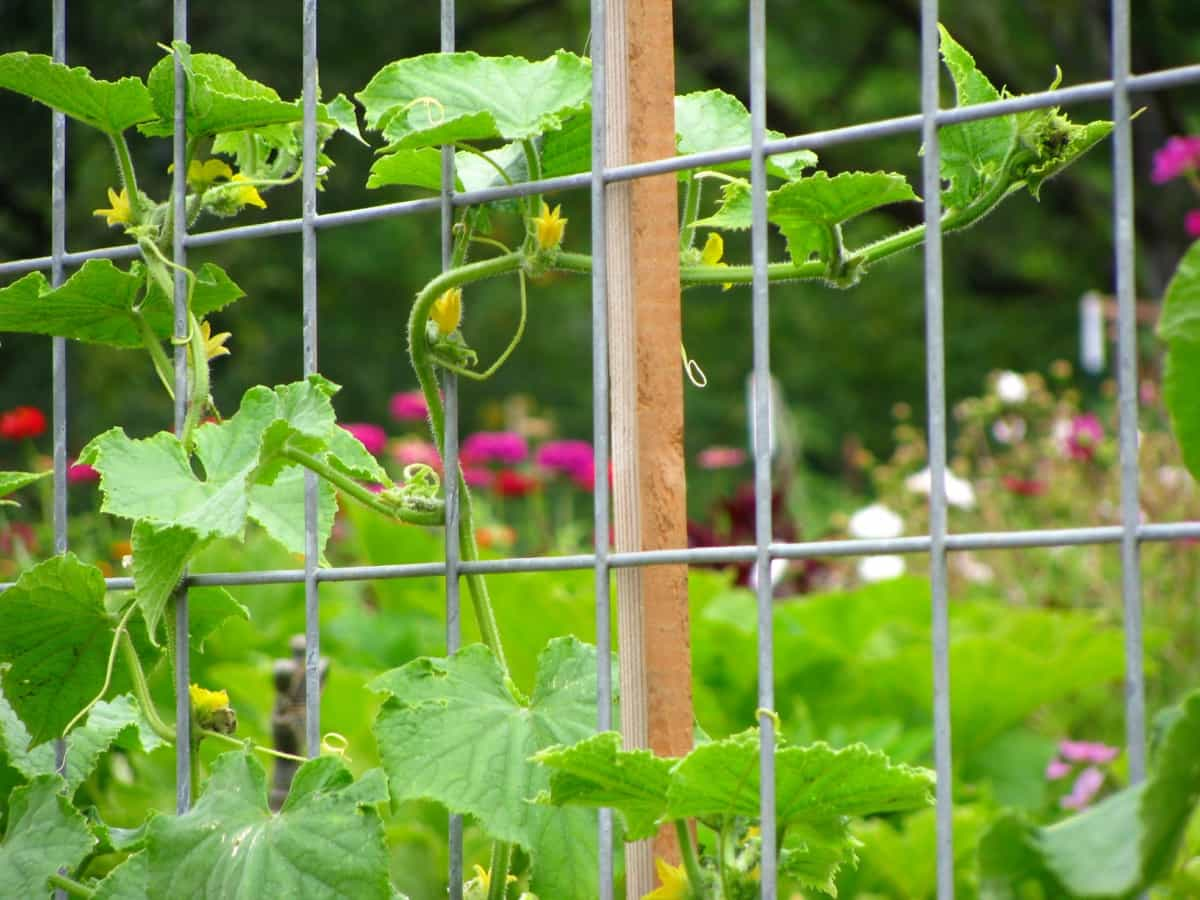
The advantage of using bamboo for trellises is its flexibility. This makes it ideal for training climbing plants such as Cucumbers, Tomatoes, and Beans. In addition to being cost-effective, bamboo trellises are also lightweight and easy to install. They need minimal maintenance and can last for several seasons if properly cared for.
Wire Trellis
Wire trellises are a versatile and affordable option for supporting your plants. Made from sturdy wire mesh or fencing, these trellises provide excellent support for climbing plants such as tomatoes, cucumbers, and vines. To build a wire trellis, start by installing wooden or metal posts at each end of your garden bed. Then, attach the wire mesh or fencing between the posts using zip ties or clips.
Make sure to stretch the wire tight to prevent sagging. They can withstand heavy loads and resist rotting over time. They can be customized to fit different plant sizes and shapes by adjusting the spacing between wires. A wire trellis offers an economical solution for vertical gardening while providing dependable support for your climbing plants without overshadowing their beauty in your garden space.
Mesh Trellis
Mesh trellises are a versatile and affordable option for supporting your plants. Made from materials like wire mesh or plastic netting, these trellises provide strong support while allowing ample airflow and sunlight to reach your plants. The open design allows you to easily train your plants to grow vertically, whether they are climbing vines, vegetables like tomatoes or cucumbers, or even flowering plants like roses.
Mesh trellises are also lightweight and easy to install. They can be attached directly to walls, fences, or stakes driven into the ground. If you prefer a freestanding structure, you can use poles or PVC pipes to create a frame for the mesh. In addition to providing support for your plants’ growth, mesh trellises also help improve air circulation around foliage.
A-Frame Trellis
This type of trellis resembles the shape of an A, with two sides that slope outward from a central point. It provides excellent support for climbing plants and adds a charming element to any garden. To build your A-Frame trellis, start by selecting sturdy wooden poles or stakes. Drive them into the ground at an angle, forming the desired width and height of your trellis. Make sure they are securely anchored in the soil to withstand strong winds or heavy plant growth. Next, connect the top ends of the poles using screws or nails.
This will create the peak of your A-Frame structure. You can also add horizontal crossbars along each side for added stability. Once your frame is complete, you can attach wire mesh or netting across both sides to provide support for your climbing plants. Secure it tightly using zip ties or twisty ties to prevent sagging as the plants grow. A-Frame trellises are ideal for vining vegetables such as cucumbers, beans, and tomatoes. They allow these plants to grow vertically while maximizing space in your garden beds or containers.
Arched Trellis
Arched trellises are a beautiful and functional addition to any garden. They can be made from various materials, such as wood or metal, allowing you to select the option that best suits your needs. When it comes to choosing plants for your arched trellis, consider climbers like Roses, Clematis, Jasmine, or Morning Glory.
In case you missed it: The Growing Trend of Urban Terrace Gardening in India for Healthy Living and Sustainability
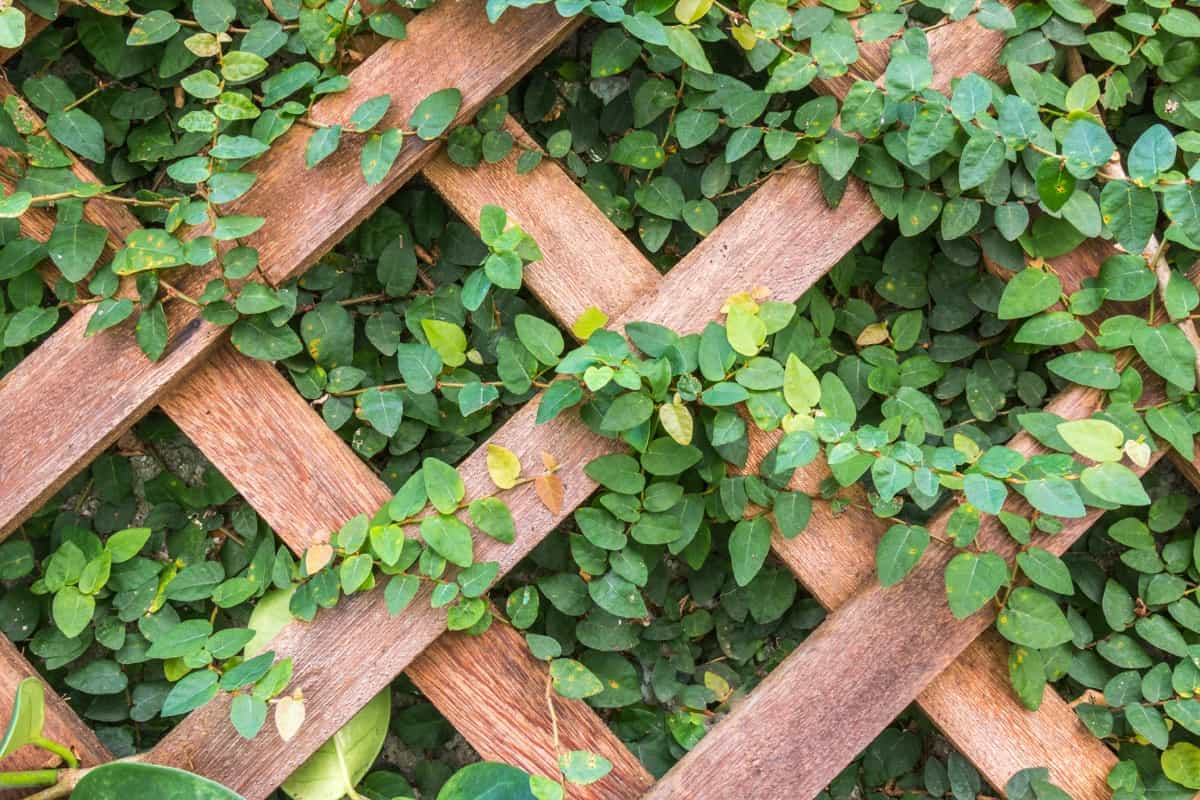
Building an arched trellis is relatively simple. Start by selecting the material you want to use – whether it’s pressure-treated lumber or galvanized steel – then cut the pieces according to your desired dimensions. Once you have all your pieces ready, assemble them using screws or nails. Place the assembled arch in your desired location in the garden, ensuring it is secure in the ground.
Obelisk Trellis
The Obelisk Trellis is a stunning addition to any garden, adding height and structure to your plants. It can be used for various types of plants, including roses, clematis, morning glory plants, and even vegetables like cucumbers or tomatoes. Building an obelisk trellis is relatively simple. You can use materials (wood or metal rods) to create the frame and then add additional supports diagonally across each side for added stability. Once constructed, you can place it directly into the ground or use large pots filled with soil for mobility.
Teepee Trellis
The teepee trellis is a versatile and practical option for supporting vining plants in your garden. Teepees are especially beneficial for growing vining plants such as Pole Beans, Garden Peas, Nasturtiums, and Fragrant Sweet Peas. Creating a teepee trellis is relatively easy too. Gather long poles such as bamboo or dowels and secure them together at the top, forming a cone shape.
String Trellis
String trellises are a simple yet effective way to support climbing plants in your garden. To create a string trellis, start by installing sturdy posts or stakes at each end of the planting area. Next, tie a horizontal string between the posts at the desired height for your plants to climb. Depending on the type of plant you’re growing, you may need multiple strings spaced evenly along the length of the trellis.
Remember to regularly check and adjust the tension of your strings as your plants grow taller and heavier. This will ensure they have proper support throughout their growth cycle. String trellises provide an affordable solution for supporting climbing plants in your garden.
Unique and Cheap Trellis Ideas
Repurposed Materials
Use old ladders, pallets, or even bicycle wheels as the base for your trellis. Not only will it save you money, but it will also give your garden a rustic and eclectic look. Old ladders can be transformed into charming vertical supports for climbing plants. Another idea is using discarded bicycle wheels as the framework for a trellis.
In case you missed it: 15 DIY Aquaponic Plans You Can Build in Your Garden
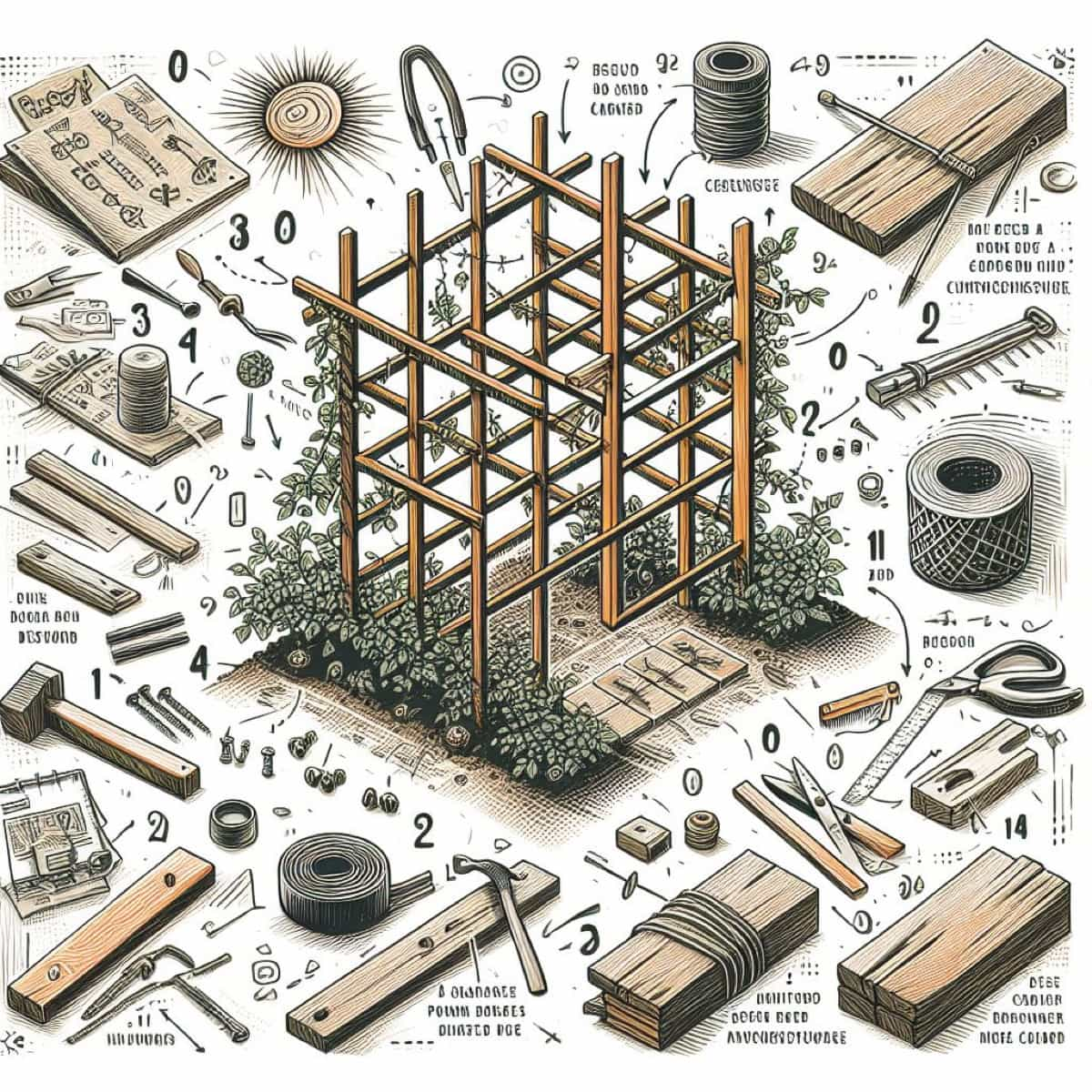
Secure them together with wire or rope, and let nature take its course as vibrant blossoms cling to their spokes. For those who love vintage charm, consider using antique window frames or doors as your trellis structure. Hang them horizontally or vertically and train your plants along the glass panes for an enchanting display.
Vertical Garden Wall
Vertical Garden Wall is a creative and space-saving way to incorporate greenery into your outdoor or indoor space. The unique idea for a vertical garden wall is to use repurposed materials such as old wooden pallets or shipping crates. Another option is to use hanging baskets or plant pockets that are specifically designed for vertical gardening.
These allow you to grow different plants in separate compartments, giving your wall a vibrant and colorful appearance. This type of vertical garden requires some planning and maintenance but can result in a truly stunning and unique feature.
DIY PVC Trellis
PVC trellises are easy to make and can be customized to fit any garden space. To create a DIY PVC trellis, start by measuring the height and width of the area where you want to place it. Then, cut your PVC pipes into equal lengths based on these measurements. Next, assemble the pieces by connecting them with elbow joints or T-joints. This will create the basic frame of your trellis.
Make sure to secure the joints tightly so that your trellis is sturdy. Once the frame is collected, you can add additional crossbars for extra support if needed. These can be attached using connector pieces or zip ties. Attach netting or wire mesh onto the frame using zip ties or clips. This will provide support for climbing plants such as cucumbers, tomatoes, or even flowers like morning glories.
Recycled Bottle Trellis
To make this trellis, start by collecting plastic bottles of various sizes and colors. Make sure to clean them thoroughly before use. Next, cut off the bottom of each bottle and remove the cap. Then, thread a strong wire or string through the neck of each bottle, ensuring they are securely fastened together.
In case you missed it: Weed Management in Cucumber Farming: Organic, Chemical, Cultural Control Methods
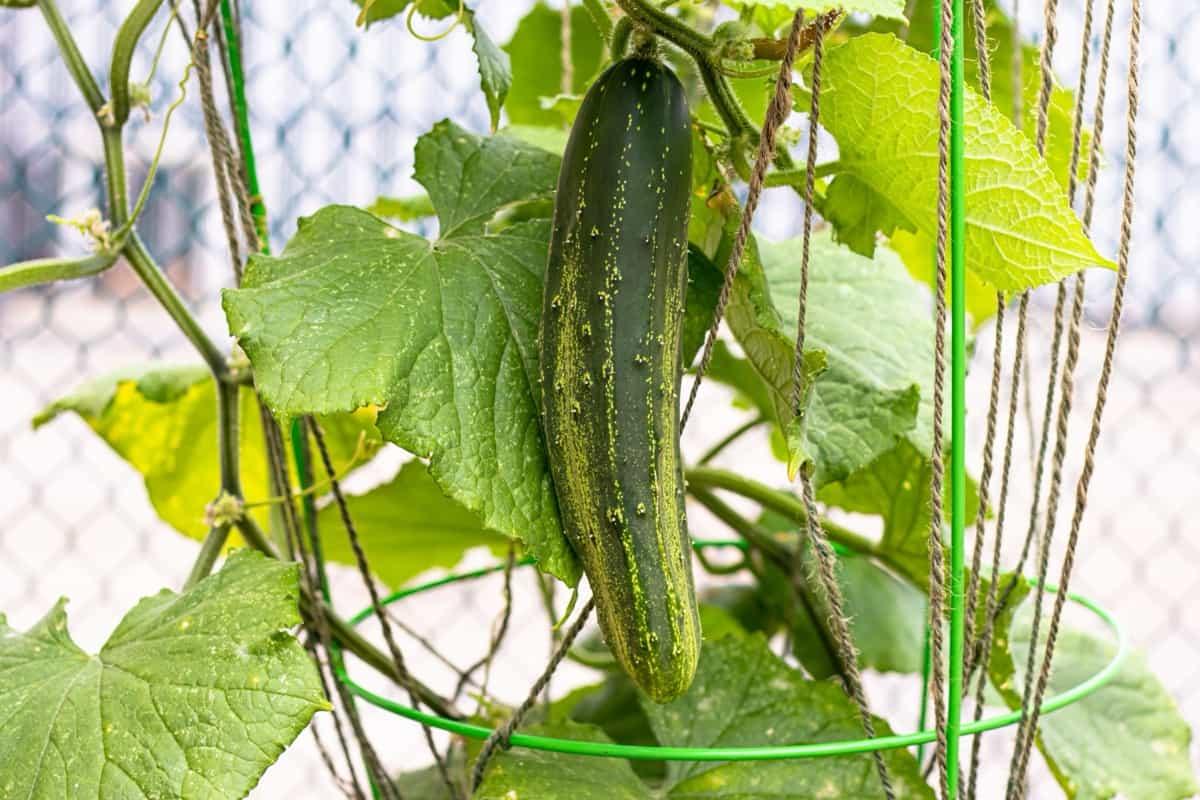
Once your bottles are connected in a row, attach them vertically to a sturdy frame or structure using zip ties. Not only does this recycled bottle trellis provide support for climbing plants like cucumbers or morning glories, but it also adds a unique touch of color and whimsy to your garden space.
Fan Trellis
These trellises are designed to resemble the shape of a handheld fan, with slats or bars that radiate out from a central point. They provide an elegant and decorative element to your garden while also serving as functional support for your plants. The open design allows you to train plants in various patterns, creating beautiful displays in your garden. In terms of plant suitability, fan trellises like Clematis, Morning Glories, or Sweet Peas work well for lightweight climbers. These delicate vines can be trained along the slats without overwhelming the structure.
Living Willow Structure
To build a Living Willow Structure, start by choosing flexible willow branches or shoots that are about 1/2 inch thick. These can be easily found in local nurseries or even harvested from your backyard if you have willow trees. Next, select the location where you want to create your structure. It could be near a fence, against a wall, or even in the middle of your garden as a focal point. Dig holes into the ground at least 6 inches deep and insert the cuttings vertically into the holes. Make sure each cutting is spaced about 4-6 inches apart.
Once all the cuttings are planted, weave them together by bending and intertwining them with each other. This process requires some patience and creativity but allows you to create intricate patterns and shapes. As time goes on, the willow branches will take root and grow, creating a beautiful living trellis that can support various climbing plants like Roses, Clematis, or Morning Glories.
Macramé Plant Hangers
Using macramé plant hangers is a great way to maximize vertical space in your garden or home. They can be hung from ceilings or even outdoor structures like pergolas or trellises. This allows you to showcase your plants in a visually appealing and creative way. Additionally, they can accommodate a variety of pot sizes and shapes, making it easy to display both small succulents and larger hanging plants. By suspending them off the ground, you allow air circulation around the foliage, which helps prevent issues such as mold or rotting roots.
Cattle Panel Archway
This sturdy structure provides ample space for climbing plants like Roses or Cucumbers while adding an eye-catching element to your garden. Secure two cattle panels together in an arch shape using zip ties or wire, then anchor them into the ground with stakes. You can train your plants along the panels as they grow, creating a stunning focal point in your outdoor space.
In case you missed it: Top 18 Best Inexpensive Raised Garden Bed Ideas: DIY for Low-Cost, Cheap, and Budget-friendly Tips
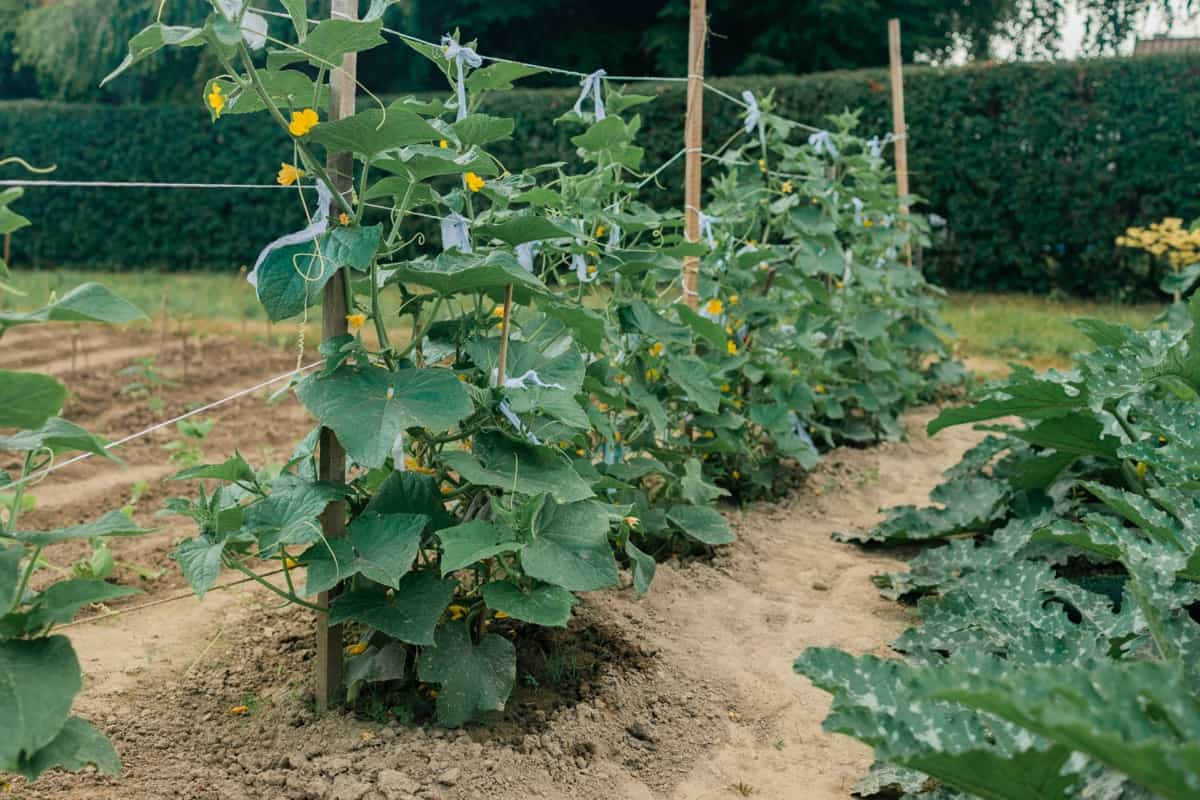
Frequently Asked Questions (FAQ) on Build Your Trellis
What Materials Should I Use for My Trellis?
There are many options available, such as wood, metal, or even PVC pipes. Choose a trellis material that suits your needs and budget.
Do I Need Any Special Tools for Building a Trellis?
Basic tools like a saw, hammer, drill, and measuring tape will suffice for most DIY projects.
Is It Necessary to Anchor the Trellis into The Ground?
Yes. Anchoring ensures stability during strong winds or when plants become heavy with fruits or flowers.
Conclusion
The main purpose of a trellis is to allow vertical growth for plants that tend to climb or vine. Providing this support system helps maximize space utilization in your garden while also creating an aesthetically pleasing arrangement. A well-designed trellis adds structure and visual appeal to your outdoor space.
- Types of Pesticides Used in Agriculture: A Beginner’s Guide
- Economical Aquaculture: A Guide to Low-Budget Fish Farming
- 15 Common Planting Errors That Can Doom Your Fruit Trees
- How to Make Houseplants Bushy: Effective Tips and Ideas
- Innovative Strategies for Boosting Coconut Pollination and Yield
- Pollination Strategies for Maximum Pumpkin Yield
- The Complete Guide to Chicken Fattening: Strategies for Maximum Growth
- Natural Solutions for Tulip Problems: 100% Effective Remedies for Leaf and Bulb-Related Issues
- Revolutionizing Citrus Preservation: Towards a Healthier, Greener Future
- Natural Solutions for Peony Leaf and Flower Problems: 100% Effective Remedies
- Maximizing Profits with Avocado Contract Farming in India: A Comprehensive Guide
- Natural Solutions for Hydrangea Problems: 100% Effective Remedies for Leaf and Flowers
- The Ultimate Guide to Choosing the Perfect Foliage Friend: Bringing Life Indoors
- From Sunlight to Sustainability: 15 Ways to Use Solar Technology in Agriculture
- The Ultimate Guide to Dong Tao Chicken: Exploring from History to Raising
- The Eco-Friendly Makeover: How to Convert Your Unused Swimming Pool into a Fish Pond
- Mastering the Art of Delaware Chicken Farming: Essentials for Healthy Backyard Flocks
- 20 Best Homemade Fertilizers for Money Plant: DIY Recipes and Application Methods
- How to Craft a Comprehensive Free-Range Chicken Farming Business Plan
- Brighten Your Flock: Raising Easter Egger Chickens for Beauty and Bounty
- How to Optimize Your Poultry Egg Farm Business Plan with These Strategies
- Subsidy for Spirulina Cultivation: How Indian Government Schemes Encouraging Spirulina Farmers
- Ultimate Guide to Raising Dominique Chickens: Breeding, Feeding, Egg-Production, and Care
- Mastering the Art of Raising Jersey Giant Chickens: Care, Feeding, and More
- Ultimate Guide to Raising Legbar Chickens: Breeding, Farming Practices, Diet, Egg-Production
- How to Raise Welsummer Chickens: A Comprehensive Guide for Beginners
- How to Protect Indoor Plants in Winter: A Comprehensive Guide
- Ultimate Guide to Grow Bag Gardening: Tips, Tricks, and Planting Ideas for Urban Gardeners
- Guide to Lotus Cultivation: How to Propagate, Plant, Grow, Care, Cost, and Profit
- Agriculture Drone Subsidy Scheme: Government Kisan Subsidy, License, and How to Apply Online
- Ultimate Guide to Raising Araucana Chickens: Breed Profile, Farming Economics, Diet, and Care
- Bringing Hydroponics to Classroom: Importance, Benefits of Learning for School Students
- Ultimate Guide to Raising Polish Chickens: Breed Profile, Farming Economics, Diet, and Care
- Ultimate Guide to Raising Australorp Chickens: Profile, Farming Economics, Egg Production, Diet, and Care
- Silkie Chicken Farming: Raising Practices, Varieties, Egg Production, Diet, and Care
- Sussex Chicken Farming: Raising Practices, Varieties, Egg Production, Diet and Care